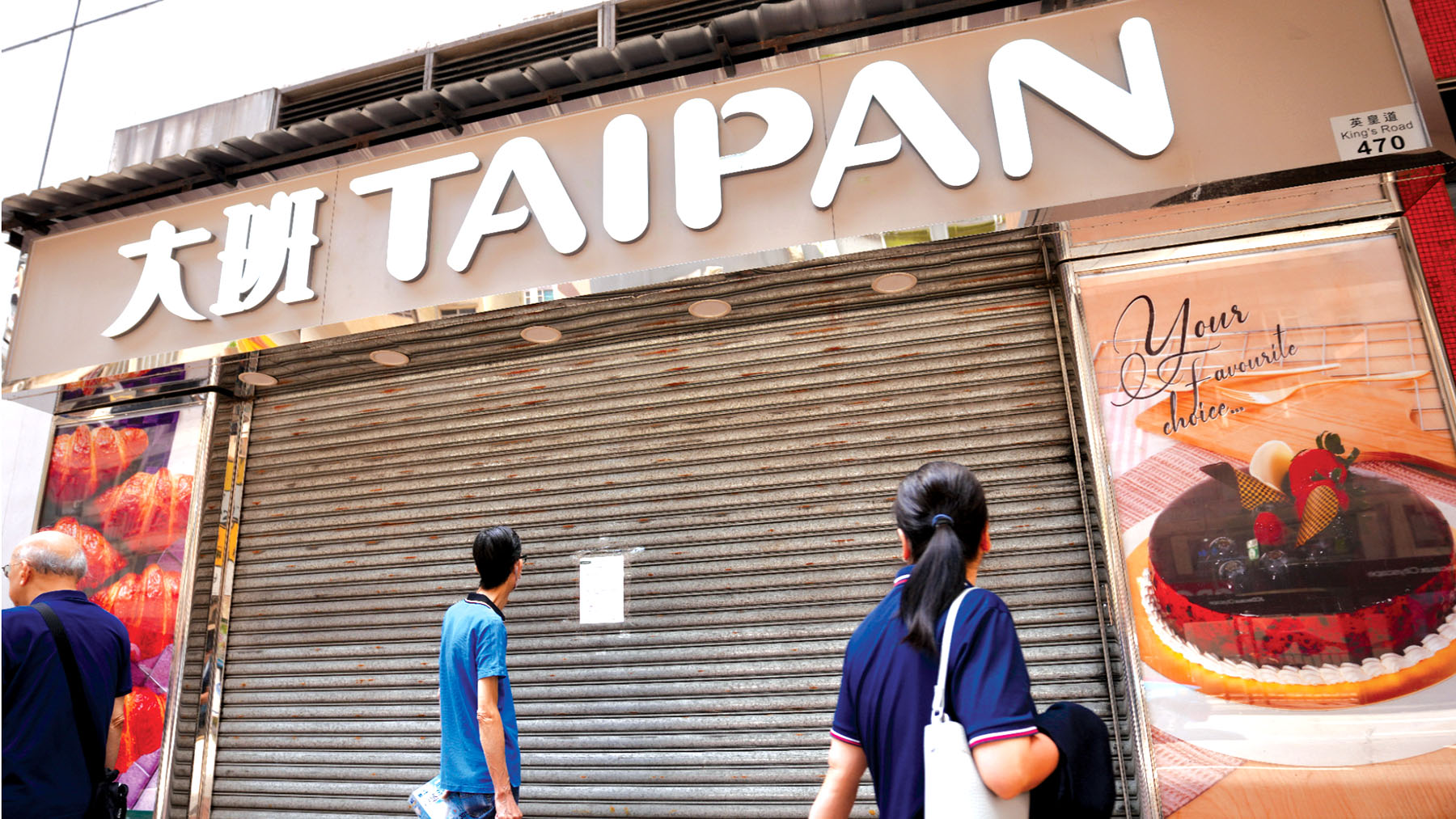Once-thriving traditional eateries are closing amid rising costs and shifting habits, but innovation and new players are reshaping the city’s food culture. Gang Wen reports.

On a humid weekday morning, Zoe Au-yeung, a Hong Kong resident in her 30s, joined a long, winding line on Tsuen Wan’s Hoi Pa Street, eager to try the HK$15 ($1.91) pancake burger — a signature offering of Tai Hing Bakery.
The air was thick with the aroma of freshly baked pastries, delighting the waiting crowd and enticing passersby. Tai Hing’s pancake burgers and HK$1 mini egg tarts have generated a social media buzz — an astute move for the bakery, which has been serving the community since 1976, helping it stand out among thousands of local small shops.
“I come here almost every week for the pancake burger,” said Au-yeung. “It smells so good — hot and fresh out of the oven. You usually have to queue, but it’s worth it.”
Tai Hing and its loyal patrons have found a recipe for survival during a challenging period for Hong Kong’s food-and-beverage sector, particularly for small and medium-sized enterprises rooted in local tradition.
READ MORE: Curtain comes down on 41-year-old HK bakery chain
Roughly 200 restaurants have closed across Hong Kong in the first half of 2025, including established names such as Taipan Bread & Cakes, and Ocean Empire Food Shop.
For many locals, the wave of closures signifies more than just the loss of eateries; it threatens a piece of the city’s cultural fabric. “These old diners and bakeries are part of our collective memory,” said Liang Muyan, a dim sum enthusiast in her 20s. “I hope the industry doesn’t blindly follow trends, but preserves the emotional value and tradition of Hong Kong food.”
Simon Wong Ka-wo, president of the Hong Kong Federation of Restaurants and Related Trades, cited soaring rents, severe labor shortages, and a shrinking local consumer base for the reasons behind the closures.
“Without urgent support and innovation, we risk losing not just businesses, but a vital part of Hong Kong’s culinary heritage,” he warned.

Multifaceted challenges
According to the Hong Kong Small and Medium Enterprises Association, operating costs now consume 68 percent of SMEs’ revenues, 15 percent higher than pre-pandemic levels.
Even iconic brands like Tsui Wah — a staple of Hong Kong’s cha chaan teng culture — are feeling the pinch.
The chain, which went public in 2012 and operates 31 outlets across the city, reported a 5 percent drop in annual revenue to HK$906 million as of March.
Chinese mainland revenues fared even worse, declining 14 percent to HK$371 million, following the closure of four outlets, leaving 32 remaining.
Ho TY, marketing and public relations officer of Tsui Wah Group, highlighted the challenges the company faces due to high rents and labor costs, adding that the company has implemented strict cost-control measures and focused on operational efficiency.
“Expanding delivery services, introducing self-service options, and boosting electronic payment systems all help increase sales per visit and offset fixed costs,” Ho said.
He said the company will evaluate whether to further adjust numbers of its outlets in response to market conditions.
Hong Kong’s F&B sector also faces setbacks from a slower-than-expected recovery in tourism and shifting consumer patterns. In 2024, Hong Kong recorded 45 million visitor trips, showing steady post-pandemic growth, but still lagging behind the 65 million trips in 2018. The forecast for 2025 is around 49 million.
Last year, 34 million trips, or about three-quarters of all visits, were made by mainland tourists, whose per capita spending has decreased by around 30 percent compared with 2018.
Meanwhile, the sector is losing ground with local diners. In 2024, Hong Kong residents made 81.91 million trips to the mainland — an increase of over 50 percent from 2023. It is estimated that Hong Kong residents spent in total HK$55.7 billion ($7 billion) on the mainland, with an average expenditure of HK$680 per trip, excluding cross-border transportation costs.
In response to these emerging challenges, the special administrative region government rolled out special loans under the SME Financing Guarantee Scheme, and funding for branding and marketing, but the effects have waned amid renewed difficulties. “Loan guarantees help with cash flow, but they don’t address fundamental issues like high rents or the digital skills gap,” said Algernon Yau Ying-wah, secretary for commerce and economic development. “Hong Kong lags behind in digitalization, especially in the F&B sector. Many traditional brands lack strong online marketing capabilities or innovative sales channels like livestreaming, which are common on the mainland.”
Against the tide
Local brands are experimenting with various survival strategies, including automation, digitalization, and new menu concepts aimed at attracting targeted groups, such as younger diners and the growing elderly population.
On July 22, some outlets of food giant Maxim’s began offering Gentlemeal, a new product line designed for people with swallowing difficulties. Developed to replace traditional liquid diets, Gentlemeal features both Chinese and Western dishes, aiming to enrich nutritional options for the elderly and patients, and ultimately, improve their quality of life.
“Senior consumers have strong spending power, but few restaurants cater to their needs,” said Yau, pointing to opportunities within the “silver economy”.
Wong agrees, saying, “The industry’s survival depends on its ability to adapt, embrace new technology, and preserve what makes Hong Kong unique.”
Amid the turbulence, many new industry players continue to open in Hong Kong, reflecting their optimism about the city’s dining scene, and leveraging the city’s role as a gateway to the international market.
Although 847 shops in Hong Kong have closed in the past six months, 786 new ones have opened, indicating continuous market vitality, according to a research report by real estate agent Midland.
Mainland restaurant chains are among those seizing the opportunities. Laomaque, a Hunan cuisine restaurant brand, launched its first restaurant outside the mainland in Hong Kong’s Wan Chai district on May 13, marking a strategic expansion.
ALSO READ: Tea breaks with tradition
“Establishing in Hong Kong aligns with our core strategy to root deeply in the Greater Bay Area,” said Laomaque CEO Dai Yong, highlighting the city’s role as a testing ground for the brand’s regional ambitions. “The move came in response to repeated requests from Hong Kong visitors, a clear sign that cross-border demand is fueling mainland brands’ localization efforts.”
Guangzhou’s Fung Yuen Cantonese-style chicken pot brand, with over 20 branches in major mainland cities, opened its first Hong Kong branch last month, aiming to use the city as a base for Southeast Asia expansion.
“Hong Kong’s open market and international standards make it the ideal springboard for many mainland brands to promote Chinese cuisine to the world,” said Xie Tian, chairman of Hong Kong Fung Yuen Yezhen Catering Management Co Ltd.
“We want to bring innovative Cantonese flavors and dining experiences to local consumers, and leverage Hong Kong’s strategic location to reach global markets,” he said.
Huang Yawen contributed to the story.


